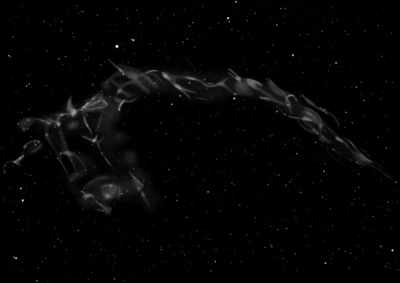
15x50 IS binoculars (8/27/11): NGC 6992/6995 is striking at just 15x using a pair of UHC filters threaded over the objectives as a long, curving filament. Although NGC 6960 through 52 Cygni was also visible in the same binocular field, it's is a tougher object, particularly the fainter (forked) southern portion.
William Herschel discovered NGC 6992 = H V-14 = h2092 on 6 Sep 1784 (sweep 258) and recorded "eF, above 3/4° long and 6, 8 or 10' broad. The whiteness entirely of the milky kind, brighter in 3 or 4 places than in the rest. The position of the ray or extent is from np to sf [northwest to southeast], making an angle of 30 or 40° with the meridian. The stars of the galaxy [Milky Way] are scattered over it in the same manner as the rest of the heavens. The time and number is taken in the brightest part of the nebula. The ray is faint enough to have been overlooked had it not been for the brighter places in it." The following night (sweep 259) he discovered the western section of the Veil Nebula NGC 6960) and reobserved the eastern section, finding "Branching nebulosity of the extent of the number that is 53' in polar distance, and in RA reaches through 5 or 6 fields that is near 1 1/2 degrees. The following part of it is divided into several streams and windings which after separating meet each other again towards the south." Herschel's rough sketch was publication in his 1811 paper (Fig. 1) as an example "of extensive diffused Nebulosity". NGC 6992 is generally applied to the northern portion of the eastern half of the Veil Nebula.
John Herschel first observed the Veil on 7 Sep 1825 (sweep 8) mentioned "The whole neighborhood seems affected with wisps or cirro-stratus-like masses of nebula." This was the original of the nickname "Cirrus Nebula", though the moniker "Veil Nebula" was probably first introduced by Leland Copeland. E.P. Mason made an excellent sketch in 1838.
200/250mm - 8" (5/21/82): bright at 50x with UHC filter. Some structure seen with darker rifts and branches at the south edge.
300/350mm - 13" (5/21/82): incredibly detailed at the south edge. Wispy structure with two long tails. Darker rifts and filamentary structure along the entire length.
400/500mm - 17.5" (7/5/86): this section of the Veil nebula is probably the most detailed and exciting emission object to explore in the 17.5" using a 20mm Nagler and OIII filter. Appears very bright, extremely large, very elongated, about 1° length, crossed by darker rifts. Feather-like side branches are at the south edge running off towards the west. The breathtaking filamentary detail at 83x using an OIII filter is too intricate to describe, particularly on the southern half! The filaments appear like intertwined threads or twisted ropes giving a striking 3-dimensional appearance along the length! Attached to NGC 6995 and IC 1340 to the south.
Notes by Steve Gottlieb